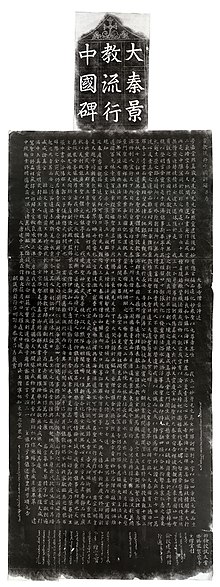ศิลาจารึกซีอาน
| ศิลาจารึกซีอาน | |||||||||||||||
 ศึลาจารึกชื่อ 大秦景教流行中國碑 สร้างขึ้นในปี 781 | |||||||||||||||
| อักษรจีนตัวเต็ม | 大秦景教流行中國碑 | ||||||||||||||
|---|---|---|---|---|---|---|---|---|---|---|---|---|---|---|---|
| อักษรจีนตัวย่อ | 大秦景教流行中国碑 | ||||||||||||||
| ความหมายตามตัวอักษร | Stele to the Propagation in China of the Jingjiao (Luminous Religion) of Daqin (Roman Empire) | ||||||||||||||
| |||||||||||||||
| ชื่อภาษาจีนอื่น ๆ | |||||||||||||||
| ภาษาจีน | 景教碑 | ||||||||||||||
| ความหมายตามตัวอักษร | Luminous Religion Stele | ||||||||||||||
| |||||||||||||||
ศิลาจารึกซีอาน (อังกฤษ: Xi'an Stele) หรือ ศิลาจารึกจิ่งเจี้ยว (จีน: 景教碑; พินอิน: Jǐngjiào bēi) หรือ "ศิลาจารึกเนสเตอร์" เป็นศิลาจารึกสมัยราชวงศ์ถัง สร้างขึ้นในปี 781 และจดบันทึกประวัติศาสตร์ 150 ปีของศาสนาคริสต์ในประเทศจีนในยุคแรก[1] ศิลาจารึกนี้เป็นหินปูนความสูง 279 เซนติเมตร (9 ฟุต 2 นิ้ว) จารึกด้วยอักษรภาษาจีนและซีเรีย บรรยายถึงการมีอยู่ของชุมชนคริสต์ชนในหลายนครในจีนตอนเหนือ และแสดงให้เห็นว่าคริสตจักรตะวันออกได้รับการยอมรับโดยจักรพรรดิไท่ซงแห่งราชวงศ์ถัง ผ่านความพยายามของคณะมิชชันนารีอาโลเปนในปี 635[2] เนื้อความของจารึกระบุว่าอาโลเปนและคณะมิชชันนารีคริสต์ศาสนาแบบซีเรียเดินทางมายังจีนผ่านทางต่าฉิน (โรมันตะวันออก) ในปีที่เก้าในรัชสมัยของจักรพรรดิไท่ซง (คือปี 635) พร้อมทั้งเอกสารและรูปเคารพต่าง ๆ[3] สงฆ์ในสังกัดคริสตจักรตะวันออกนามว่าอาดัม เป็นผู้พรรณาเนื้อความบนจารึกนี้[4]
จารึกถูกฝังในปี 845 เป็นไปได้ว่าระหว่างการกดขี่ทางศาสนา[5] ซึ่งไล่ล่าประหารชีวิตพุทธศาสนิกชนแต่ก็กระทบต่อคริสต์ศาสนิกชนเช่นกัน[6] จารึกได้ถูกค้นพบอีกครั้งในสมัยราชวงศ์หมิงในปี 1625 ด้านหลังวัดชงเริน (Chongren Temple; 崇仁寺) นอกนครซีอาน[7] ตามบันทึกของนักบวชคณะเยสุอิต อัลวาโร เซเมโด คนงานที่ค้นพบจารึกนี้ได้นำไปรายงานต่อผู้ว่าการเมืองทันที ต่อมาผู้ว่าได้เดินทางมายังพื้นที่ที่ขุดพบ แล้วมีคำสั่งให้ก่อสร้างฐานและหลังคาครอบ รวมถึงมอบหมายให้อารามพุทธแห่งหนึ่งที่ตั้งอยู่ใกล้กันเป็นผู้ดูแล[8] ปัจจุบัน จารึกจัดแสดงอยู่ที่ป่าจารึกในซีอาน ประเทศจีน
อ้างอิง
[แก้]- ↑ Hill, Henry, บ.ก. (1988). Light from the East: A Symposium on the Oriental Orthodox and Assyrian Churches. Toronto, Canada. pp. 108 109.
- ↑ Jenkins, Peter (2008). The Lost History of Christianity: the Thousand-Year Golden Age of the Church in the Middle East, Africa, and Asia - and How It Died. New York: Harper Collins. pp. 65. ISBN 978-0-06-147280-0.
- ↑ Ding, Wang (2006). "Remnants of Christianity from Chinese Central Asia in Medieval ages". ใน Malek, Roman; Hofrichter, Peter (บ.ก.). Jingjiao: the Church of the East in China and Central Asia. Steyler Verlagsbuchhandlung GmbH. ISBN 978-3-8050-0534-0.
- ↑ Godwin, R. Todd (2018). Persian Christians at the Chinese Court: The Xi'an Stele and the Early Medieval Church of the East. Bloomsbury Publishing. p. 10. ISBN 978-1-78673-316-0.
- ↑ McGrath, Anastasia (2021-02-10). "China's Buried Christian History". SAPIENTIA (ภาษาอังกฤษ). Fordham University. สืบค้นเมื่อ 2023-03-02.
- ↑ Mungello, David E. (1989). Curious Land: Jesuit Accommodation and the Origins of Sinology. University of Hawaii Press. p. 165. ISBN 0-8248-1219-0.
- ↑ Saeki, P.Y. (1951). Nestorian Documents and Relics in China (2nd ed.). Tokyo: Maruzen.
- ↑ Mungello, p. 168
แหล่งข้อมูลอื่น
[แก้]- Henri Havret sj, La stèle chrétienne de Si Ngan-fou, Parts 1–3. เนื้อหาเต็มเข้าถึงได้จาก Gallica:
บางตอนสามารถพบได้บน on archive.org.
- Carus, Paul; Wylie, Alexander; Holm, Frits (1909), The Nestorian Monument: An Ancient Record of Christianity in China, with Special Reference to the expedition of Frits V. Holm..., The Open court publishing company
- Holm, Frits (2001), My Nestorian Adventure in China: A Popular Account of the Holm-Nestorian Expedition to Sian-Fu and Its Results, Volume 6 of Georgias reprint series, Gorgias Press LLC, ISBN 0-9713097-6-0. Originally published by: Hutchinson & Co, London, 1924.
- Keevak, Michael (2008), The Story of a Stele: China's Nestorian Monument and Its Reception in the West, 1625-1916, ISBN 978-962-209-895-4
- Stele text in English from researchers at Fordham University; actually 1855 translation of A. Wiley
- Large photograph of a rubbing of the stele from University of Birmingham (scroll to bottom of page) เก็บถาวร 2009-04-23 ที่ เวย์แบ็กแมชชีน
- "The Jesus Messiah of Xi'an" ― translation and exposition of doctrinal passages in the stele text. From B. Vermander (ed.), Le Christ Chinois, Héritages et espérance (Paris: Desclée de Brouwer, 1998).
- Photos of a replica of the Nestorian Stele in Xi-an; photos are of a replica located in Japan Japanese text.
- SIR E. A. WALLIS BUDGE, KT., THE MONKS OF KUBLAl KHAN EMPEROR OF CHINA (1928) - contains reproductions of early photographs of the stele where it stood in the early 20th century (from Havret etc.)
- Nestorian Stele – Inscription: A slice of Christian history from China. Australian Museum.
